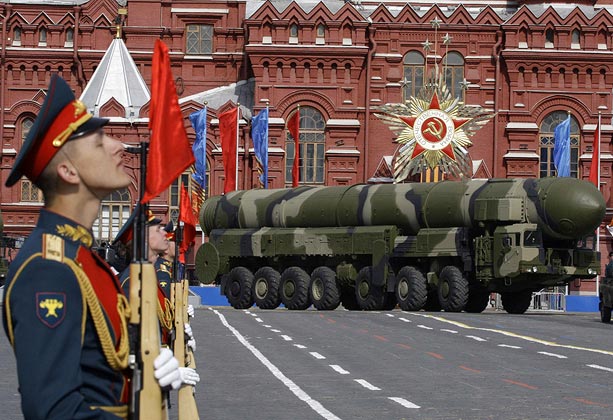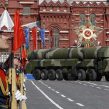
“Falsifiers of History” Targeted by the Kremlin
Publication: Eurasia Daily Monitor Volume: 6 Issue: 92
By:

In a special video posting on his official Kremlin blog President Dmitry Medvedev emphasized that the World War II Victory-Day on May 9 is an "all-Russian celebration, uniting the entire nation." But it is not all positive. Around half of Medvedev’s video address was spent on renouncing "the falsifiers of history, who are becoming increasingly vicious, ugly and aggressive." Medvedev announced, "We must defend historic truth, though it is not easy and sometimes revolting. We cannot close our eyes to the terrible truth of the war, but we will not allow anyone to undermine the sacrifice of our people" (www.kremlin.ru, May 7).
Moscow has recently accused the authorities in the Baltic republics and Ukraine of rehabilitating WWII-era nationalistic Nazi collaborators. But Medvedev’s statement was vague on who in particular are the villains. The ruling United Russia party has introduced legislation into the State Duma that will make it a criminal offense to "question the Soviet victory in WWII," punishable with a large fine and a prison sentence. Liberal commentators on radio Ekho Moskvy believe this legislation may be used not only against someone in the Baltic or in Ukraine, who are beyond Russian jurisdiction, but to punish liberal historians or dissidents, who question or investigate communist crimes (www.echo.msk.ru, May 8).
The "anti-falsification" legislation may be used to brand political opponents of the present regime as traitors. Recent opinion polls show that the Russian public has a unique opinion of WWII. A poll by VtSIOM showed that 77 percent of Russians believe the Red Army liberated the East European nations from Nazi occupation, and then allowed them to freely live and develop. Only 11 percent believe that the Soviet Union imposed pro-communist regimes and undermined the independence of the former Warsaw Pact nations. A sizable majority (60 percent) agree that anyone, who publicly opposes the "Soviet victory and sacrifice," is a felon (Interfax, May 9).
This pro-communist public nostalgia and the staunch survival of Soviet myths denying the occupation of Eastern Europe by the Red Army after WWII, is cultivated and supported by official Russian propaganda. Not only does the older Soviet-educated population believe the narrative, but the majority of younger people also accept it (Interfax, May 9). The restoration of Soviet-style massive displays of military might on May 9 on Red Square is a deliberate pragmatic policy by the present regime, hoping to gain more legitimacy by parading itself as a direct successor of Soviet communist greatness.
The last Soviet military parade on Red Square was in November 1990. In 1995 parades on Red Square resumed, but they were relatively low-key reviews with no tanks or heavy hardware. President Vladimir Putin ordered the resumption of Soviet-style military parades on Red Square in 2008 (EDM, May 7, 2008). This years’ show had added magnificence. The number of soldiers on parade increased from 6,952 in 2008 to 8,729 in 2009. The number of aircraft that flew over Red Square increased from 32 to 69 (Interfax, April 15).
During the Cold War foreign military diplomats in Moscow used the annual parades on Red Square to gain a glimpse of new secret Soviet military hardware. However, the present defense intelligence significance of the parade is negligible. New Russian military equipment may be found at international arms shows, where it is easier to examine, than during a swift drive-by. Moreover, the hardware on Red Square is almost entirely old Soviet equipment. This year the authorities boasted the presence of new S-400 anti-aircraft missiles (Interfax, May 9). But only launchers with tubes, slightly longer than the well-known S-300 were on parade, without the more important radars and control-center vehicles.
The Cold War parades were primarily aimed to impress and deter foreign powers. The present ones are mainly for internal consumption to impress the public and shame the "falsifiers." The most significant manpower increase this year among the units on Red Square was the joint forces military orchestra – from 500 in 2008 to 1,100 in 2009 – ensuring that the martial music would be louder. Another significant change – last week battalion-sized parade columns were goose-stepping on Red Square, Soviet-style 20 men in a row instead of 12 as since 1995 – increasing their echo off the Kremlin walls (Rossiyskaya Gazeta, May 7).
The Victory-Day parades were held not only in Moscow, but also in St. Petersburg and in most other major Russian cities. The army command announced that 26,000 men and some 600 army tanks and guns were planned for parades across Russia (RIA Novosti, May 8). This number does not include men from other armed services and ministries, so the final figure must be much higher. More than 200,000 policemen and 12,000 Interior Ministry troops were mobilized to keep order on May 9 nationwide (RIA Novosti, May 9).
It seems that tens if not hundreds of thousands of people were working hard for several months to produce the May 9 show, at a cost that is virtually impossible to fully establish, since the money came from many different local and federal budgets. A full-scale replica of Red Square was built near Moscow to train the parade troops. According to Defense Minister Anatoly Serdyukov, the scope of the Soviet-style parade as been somewhat exceeded and "it is expensive, but on this we must not economize" (Rossiyskaya Gazeta, May 7).




